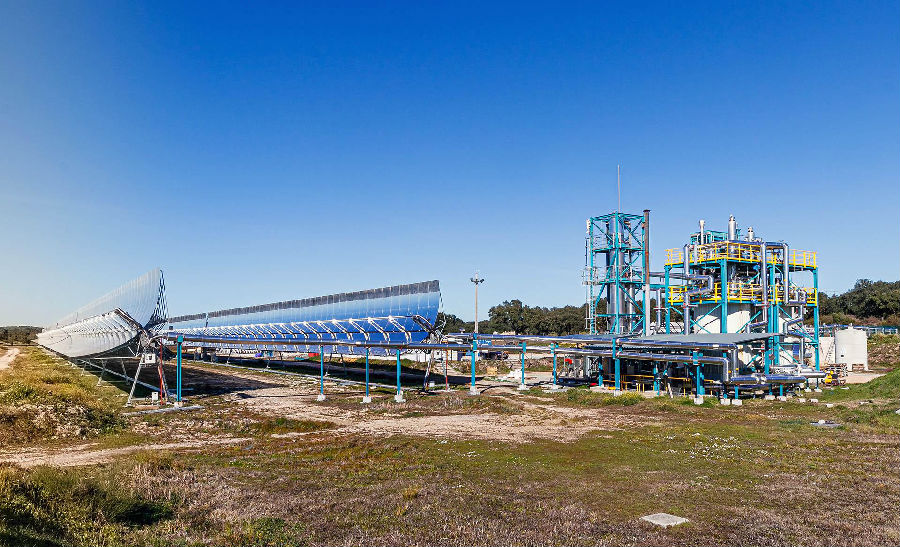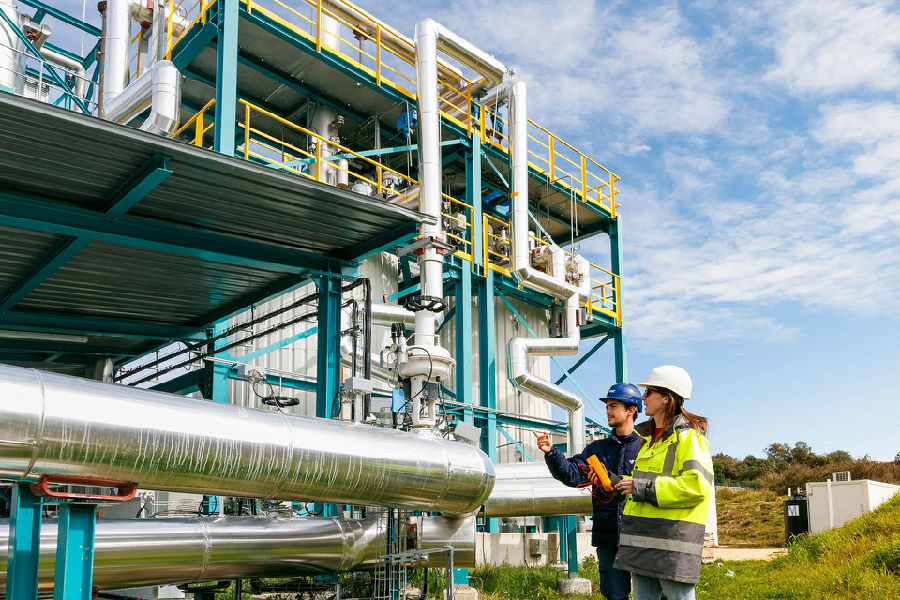Home > Market > Other Regions > Here
Salt makes Concentrated Solar Power more cost-effective – Unique test plant inaugurated
2022.05.05 From: helioscsp
Solar thermal power plants use concentrated sunlight to first generate heat and then electricity. They are already in use today in particularly sunny regions, such as Spain, the USA or Chile. To further advance this technology and make it more competitive, the German Aerospace Center (Deutsches Zentrum fuer Luft- und Raumfahrt; DLR), together with the Portuguese University of Evora and European industrial partners, has built and commissioned a unique test facility. The Evora Molten Salt Platform (EMSP) is one of the world’s first plants to use molten salt instead of thermal oil as a heat transfer medium. The official inauguration took place on 28 April 2022 in the presence of representatives of the project partners and the Portuguese and German governments.
«Today we begin operating the Evora Molten Salt Platform (EMSP) with the aim of converting the energy of the Sun into controllable electricity. To do this, we are using molten salt – an innovative and competitive technology – to transfer and store heat. The activities developed so far on the EMSP platform prove and validate the feasibility of this type of solar thermal power plant. Considering the goals of the energy transition and the energy crisis that Europe is experiencing, today’s opening is a special day – for us as a university, for the region, for Portugal and for Europe,» said the Rector of the University of Evora, Ana Costa Freitas. «Using the energy of the Sun in such a productive way is certainly a field with great possibilities. At the same time, the project is an example of excellent research, good technology transfer and productive networks.»

«The Evora Molten Salt Platform is an important step towards advancing solar thermal power as a technology for the energy transition. This facility enables us to test the use of molten salt at the power plant scale for its reliability and operational safety. Both are important criteria for moving quickly from laboratory scale to industrial application and increasing competitiveness,» said Karsten Lemmer, the DLR Executive Board Member responsible for Innovation, Transfer and Research Infrastructure, at the inauguration. «DLR is one of the pioneers of this technology; already today, almost every solar thermal power plant contains some of our expertise. We want to continue this success story together with our partners from scientific research and industry.»

Molten salt as a heat transfer medium – lower costs, higher temperatures, but difficult handling Molten salt can be used at temperatures of up to 550 degrees Celsius. For thermal oil, the limit is 400 degrees Celsius. The higher temperature range of molten salt has the decisive advantage that the conversion of solar energy into thermal energy and ultimately electricity takes place more efficiently. Solar thermal power plants using molten salt could thus provide electricity up to 20 percent lower in cost.
Technologically, however, the use of molten salt is challenging, because the salt must be kept at a constant high temperature to remain liquid. Depending on the type, the salt only liquefies at between 130 and 240 degrees Celsius. Below that temperature, it solidifies again, which can damage components and shut down the plant. Researchers at the DLR Institute of Solar Research have therefore specially designed all components and the entire system to keep the temperatures high and safely above the melting point. An electric heater also ensures that the salt does not solidify when the system is first filled and during operation.
A total of approximately 88 tonnes of salt circulate in the pipelines and tanks of the test facility. This salt is also used in a similar manner as fertiliser and is traded worldwide at a scale of 100 million tonnes.
How concentrated solar radiation is turned into heat and electricity
The test plant works with parabolic trough collectors – special, curved mirrors that stand in two long, parallel rows. They have a total length of almost 700 metres and focus the solar radiation onto pipes in the middle of the troughs. The pipes contain a heat transfer medium – in this case molten salt. This absorbs the thermal energy from the concentrated solar radiation and transports it away to be used. This energy can be used to evaporate water. The resulting steam is then used to drive a generator via a turbine, thus producing electricity. Alternatively, the heat transfer medium and thus the thermal energy itself can be stored in large tanks for up to 12 hours.
The solar field of the EMSP has a total output of 3.5 megawatts. The four parabolic trough collectors connected in series form what is referred to as a collector loop, the smallest basic element. For commercial plants, 50 to 100 such collector loops would be connected to provide the required energy.
Controllable renewable energy – solar thermal makes it possible
Currently, the cost of electricity from solar thermal power plants is higher than from photovoltaics. However, solar thermal plants have a decisive advantage due to their integrated heat storage – they can also produce power when it is cloudy and at night. This makes them one of the few options currently available for providing renewable energy in a continuous and controllable manner. In suitably sunny areas, they could therefore contribute to securing the base load in the future – as a sustainable alternative to gas, coal or nuclear power plants.
In Germany, solar thermal power plants will not be economically viable for electricity generation in the foreseeable future. However, the technology represents an interesting prospect for supplying industry – for example in the food sector – with process heat from renewable sources in Germany as well, thus contributing to the thermal transition. Such plants would then tend to be smaller in size and would be built on the premises of the user companies.
Industrial partners and funding
The DLR Institute of Solar Research leads the consortium and is responsible for the planning, conceptual design and qualification of the collector field. It also monitors the scientific test operations. The University of Evora is the owner of the Evora Molten Salt Platform test facility and is supporting the construction and operation of the plant infrastructure with operating personnel and scientific staff. The industrial partners include the companies TSK Flagsol, YARA, Rioglass, Steinmueller Engineering, eltherm and RWE.
The work on the test facility is taking place within the framework of the High Performance Solar 2 (HPS2) research project. It is funded by the German Federal Ministry for Economic Affairs and Climate Action (Bundesministerium fuer Wirtschaft und Klimaschutz; BMWK), the Portuguese Foundation for Science and Technology (Fundacao para a Ciencia e Tecnologia; FCT) and the Alentejo Regional Operational Programme (Programa Operacional Regional do Alentejo).
More from CSP Focus
NextENGIE announces 650 MW of renewable energy offtake contracts with Amazon
CSP capex costs fall by almost half as developers shift towards China and Middle East
DEWA Seeking IPP Advisory Services For 5th Phase Of MBR Solar Park
CSP Focus unveil 2020 Program for concentrated solar power industry
Is There a More Efficient Way to Generate Clean Energy with Concentrated Solar Power?
DiCaprio study: '100% renewables will save trillions of dollars'
Leave your thoughts here
Reports(Member Only)
See more+-
CSP Focus Membership Proposals
We are now proposing CSP Focus Membership, hoping to better serve our members to keep pace with the latest updates of ongoing CSP projects worldwide, and to establish and maintain business relations with major shareholders of the projects. CSP Focus offers to Membership exclusive access to:1. Daily/Weekly update and analysis on CSP policies, projects, technologies, market trend and corporate relea
-
The Latest CSP Focus Monthly Update
Join CSP Focus Membership to Get the Latest CSP Focus Monthly Update December Edition.
-
CSP Project Monthly Update 2022 December Edition
CSP Focus is presenting CSP Project (China) Update 2022 December Edition.Detail report is available for CSP Focus Membership.
-
Presentations-CSP Focus China 2021
The Report is for CSP Focus Members only.
Upcoming Events
See more+-
12th CSP Focus China 2022
2022.04.21-22 Beijing
-
11th CSP Focus China 2021
2021.10.28-29 Beijing
-
10th CSP Focus China 2020
2020.10.22-23 Beijing, China
Project Updates
See more+-
Lanzhou Dacheng Dunhuang CSP Project
Asia Pacific-China,Operational,Parabolic Trough
-
Luneng Haixi 50MW Molten Salt Tower CSP Project
Asia Pacific-China,Operational,Power Tower
-
Dubai 950MW NOOR Energy 1 CSP+PV Project
MENA-UAE,Under construction,Power Tower
-
Power China Gonghe 50MW Molten Salt Tower CSP Project
Asia Pacific-China,Operational,Power Tower





